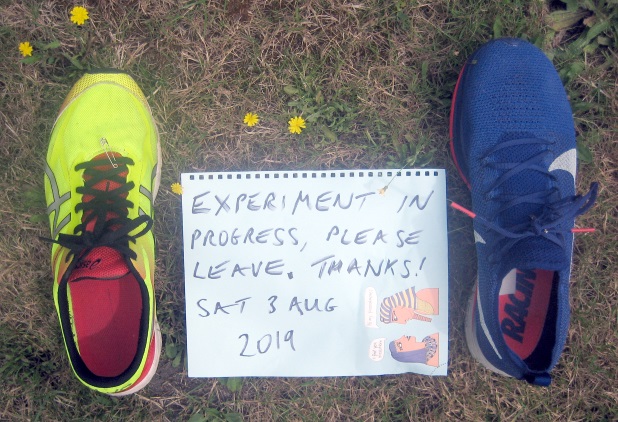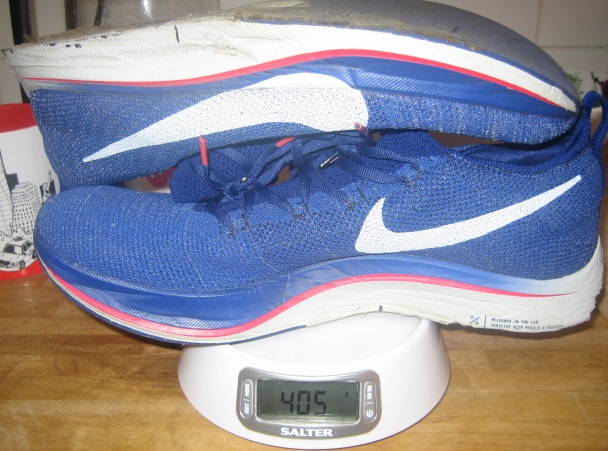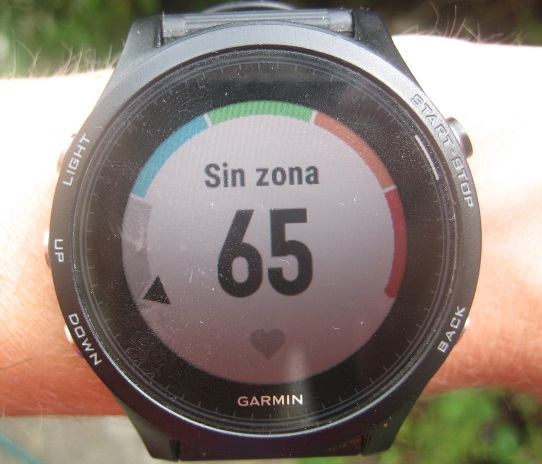

I wrote previously about how and why I chop the heels off my race shoes, and that I'd finally given in and bought some much-vaunted Nike Vaporfly 4%. But would they really make me run faster? Only one way to find out -- a careful measurement experiment.

For some years I've been racing marathons in ASICS Hyperspeed 6 shoes. With my custom modifications, they're super-light (~153 g each, size 10) but with reasonable forefoot padding.

The Nike Vaporfly 4% (and now NEXT%) have taken the marathon world by storm, claiming to improve running economy by 4%, largely due to the large thickness of forefoot energy-return foam, somehow assisted by a carbon fibre plate. My modified ones weigh ~203g each (size 10), significantly more than the Hyperspeeds. Can the design really outweigh the weight penalty? Consider, weight on the foot has to be accelerated, lifted and braked with each stride; it's way more important than weight on the body.
I ran alternately in the two types of shoe, varying everything else as little as possible. I decided to aim for fixed effort, displaying only heart rate on my watch, so I would not be influenced by any knowledge of time or pace. I used a chest strap for reliability and quicker response (compared to wrist-based HR). I ran 12 laps of a measured 770m loop on a windless morning, so 6 laps with each shoe. Before each measured lap I ran about 300m to try and stabilise my HR to the target value of 145 bpm, and then began the measured loop always from the same point with that flying start. I tried to hold 145 bpm for the duration of the lap. I wasn't great at this, but stayed within a couple of bpm generally.

Overall my performance worsened during the experiment as my legs fatigued and I heated up in the warming morning, but as I was switching shoes frequently, that wasn't too much of a problem. My legs weren't 100% fresh with a 5K race 36hr before, and I'd generally been carb-depleting a bit with an ultra coming up, though I had scoffed a lot of carbs the evening before. But the legs were in reasonably good shape. And the HR (if not pace) was around that I'd hit in a marathon, so my gait should have been reasonably close to race-representative, even if my pace was a bit slow.
My raw data and manipulations are available here in this spreadsheet if you want to noodle with it. The complete run is available here on Garmin Connect and here on Strava. Here are the headline numbers extracted from the 12 laps:
| Quantity | Hyperspeed | Vaporfly |
| Aerobic efficiency (beats/mile) | 986 +/- 6 | 974 +/- 5 |
| Avg heart rate (beats/min) | 145.3 +/- 0.2 | 144.8 +/- 0.2 |
| Speed (m/s) | 3.95 +/- 0.03 | 3.99 +/- 0.02 |
| Time (sec) | 194.8 +/- 1.3 | 193.2 +/- 1.2 |
So on average, I was (unintentionally) working a little harder in the Hyperspeeds, but ran a little faster in the Vaporflys. "Aerobic efficiency" aims to normalise performance to effort, so that should be the best measure. So my headline is:
That improvement is right on the edge of the size of the error bars of my measurements, if taken as a list without considering their sequence. However, my diminishing performance during the run artificially increases the apparent variance of the points; it is more instructive to see a graph, which does show a clear trend of the Vaporflys coming out better than the Hyperspeeds:


Despite their higher weight, the Vaporflys really did give me better speed for the same effort. 1.2% of a 2hr45 marathon is 2 minutes -- given that I had some years with a ridiculously small standard deviation of 30 sec between marathons, that is significant indeed. The number is a long way from Nike's claimed 4%, but bear in mind I put them up against shoes I had already chosen and honed for maximum efficiency.
Qualitatively, the Hyperspeeds felt harsh underfoot compared to the cushy Vaporflys as time went on, something that would be very welcome in a long race. The Vaporflys felt a bit clompy, but you get used to it.
Next I should get some NEXT%, which should be a little better and lighter, and re-run this experiment with the two types of Vaporfly -- before chopping the heels off the new ones if my modified ones come out better, obviously!